Vembu BDRSuite v5.5 is Generally Available now! We would like to share some of its most interesting and important features with our customers in a series of blogs.
BDRSuite – #1 Cost-Effective Backup Software
BDRSuite is a Comprehensive and Cost-Effective Backup & Disaster Recovery Software designed to protect data across Data Center/Private Cloud (VMware, Hyper-V, Windows, Linux, Applications & Databases), Public Cloud (AWS), SaaS (Microsoft 365, Google Workspace), and Endpoints (Windows, Mac).
We will discuss the new feature – “Restore User Mailbox to a Different Organization” in this blog.
Feature Overview: Restore User Mailbox to a Different Organization
BDRSuite for Microsoft 365 offers backup and recovery for User Mailbox, Group Mailbox, SharePoint Sites, and Teams.
BDRSuite already supports restoring the entire backed up user’s mails & archive mailbox(in-place archive) to the source user mailbox (or) to a different mailbox in the same organization.
From BDRSuite v5.5.0, users can restore the user mails to a mailbox in the different organization.
Let’s look into the step-by-step instructions on how to backup User Mailbox and restore it to a different organization.
How to Backup User Mailbox from Microsoft 365 Organization
Step 1: Setup BDRSuite Backup Server
Download and Install BDRSuite Backup Server. Click here for installation instructions.
Step 2: Configuring Backup Repository to Store Backup Data
- Navigate to Backup Server Tile -> Block Storage (or) Backup Server Tile -> Object Storage
- BDRSuite supports a wide range of scalable storage targets as backup repositories:
- Block Storages – Direct, NAS, SAN
- Object Storages – AWS S3, Azure Blob, & S3 Compatible storage like Wasabi, Backblaze, etc
Refer to BDRSuite User Guide for more details on backup repository configuration
Step 3: Add Microsoft 365 Organization
1. Log in to the BDRSuite Server console and click on the Tab: Microsoft 365/Google Workspace.
2. Navigate to Data Sources -> Add Microsoft 365 Organization page and click on the ‘Add Microsoft 365 Organization’ button which opens a dialog box.
3. On the first page – ‘Add Method Selection’, you will have three different methods to add your M365 organization on the BDRSuite.
Adding Microsoft organization account and authorizing BDRSuite automatically
Adding a Microsoft organization account and authorizing BDRSuite manually
Adding a Microsoft organization account and authorizing BDRSuite using PowerShell Scripts
Note: Please refer to the attached PDF for more information on each method.
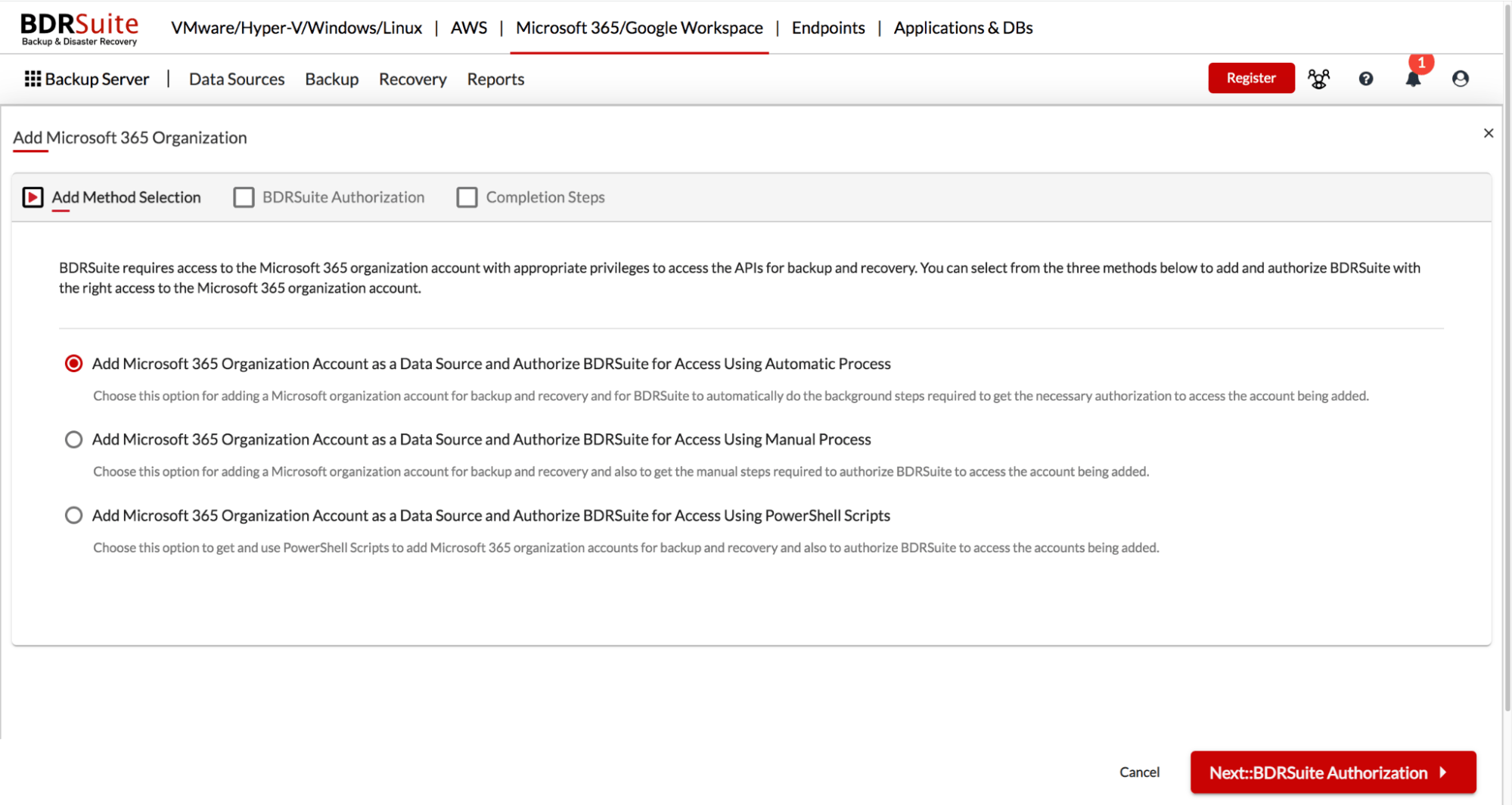
4. Once your Microsoft 365 Organization(s) are saved to BDRSuite, you can then configure backup for your entire organization (or) specific objects in your organization.
Step 4: Configuring Backup for User Mailbox (Mails & Archive Mailbox)
1. Navigate to Backup -> Configure Backup -> Microsoft 365 page.
2. Basic Job Details page: Specify a name for the backup job, select the backup repository where you want to store the data, and then provide a job description (optional). Then, click Next.
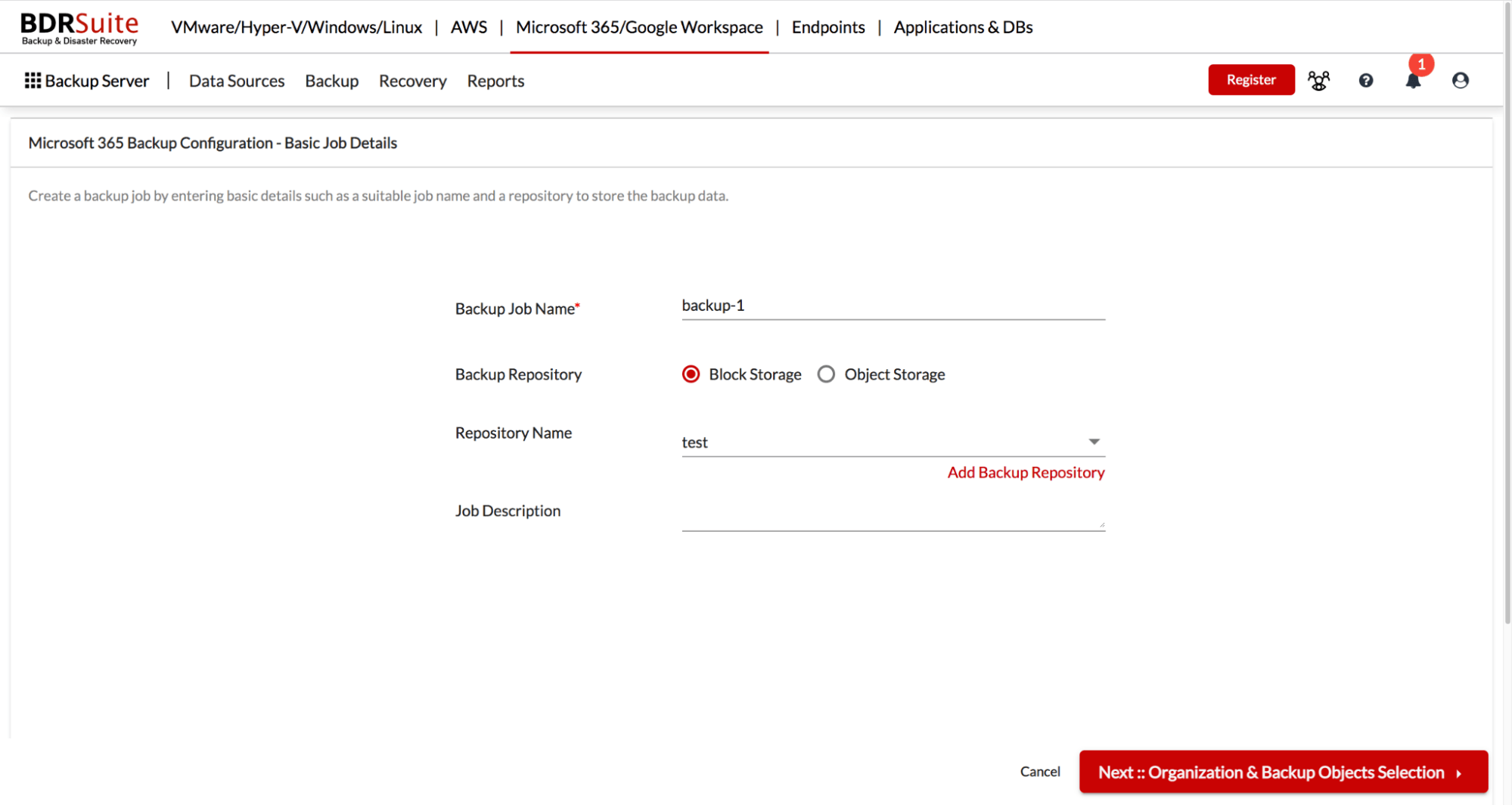
3. Organization & Backup Object Selection: In this screen, you can select an entire organization or only the objects you want to backup. Here we will select User Mailbox and then proceed to the next step.
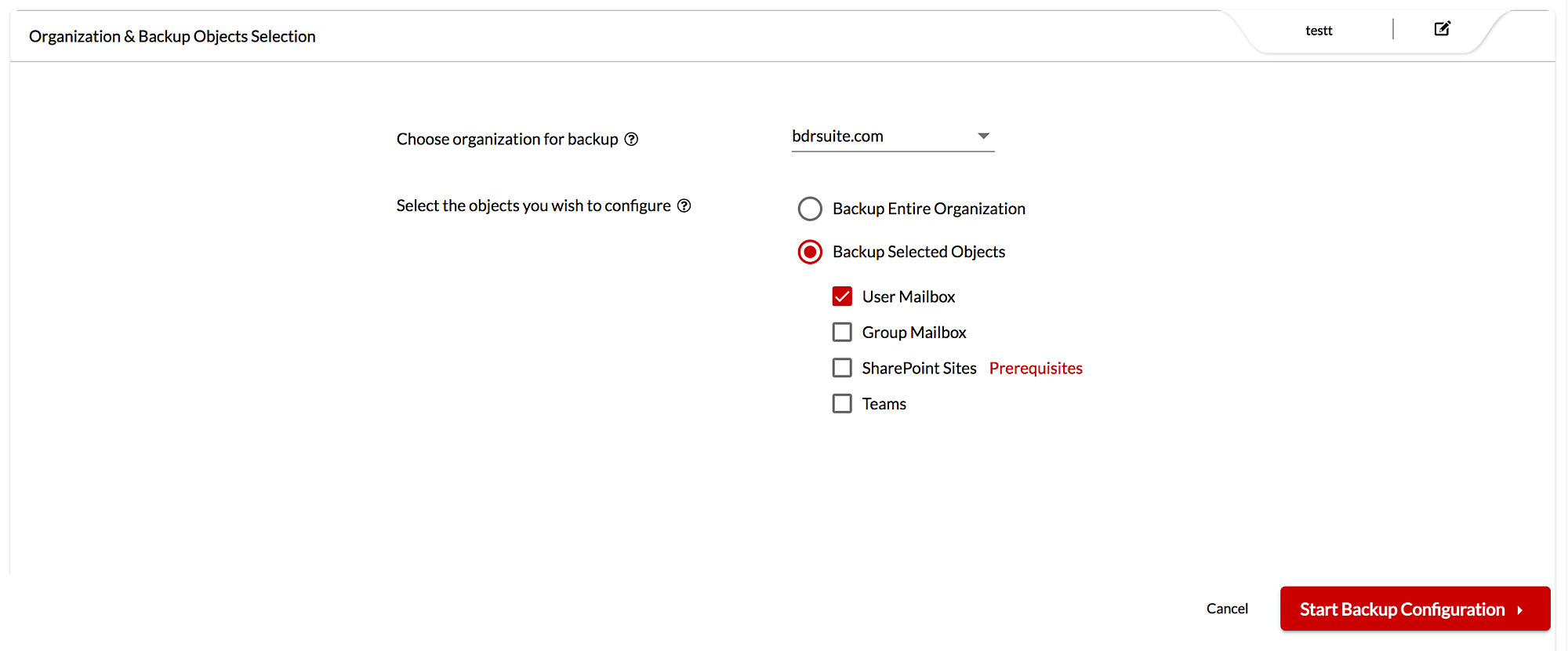
4.User Mailbox:
- Select Domain: All the Domains available in your Microsoft 365 organization will be listed. You can choose all domains or specific domains under which you want to select users
- User Selection: You can select all the users or specific users or users by groups for backup
- Select Data: You can choose user items that you want to backup. Mails, Archive Mails, Calendars, Contacts, OneDrive can be selected for Backup. Here I’m selecting Mails & Archive Mailbox alone as these can be restored to different organizations
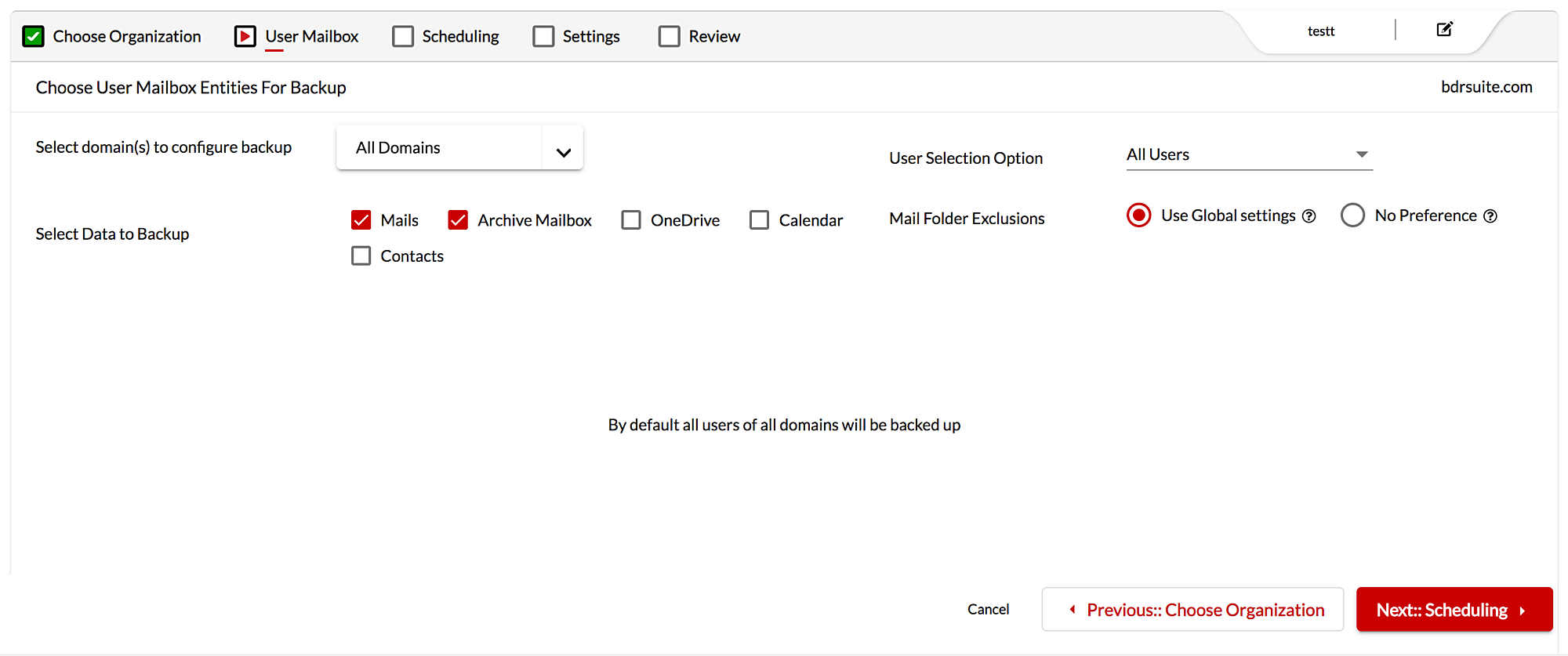
5. Scheduling:
On this screen, you need to configure how frequently you want to backup. You can backup every few mins/hours, daily/weekly/monthly basis, and even one-time. You can also set retry attempts on backup failure and wait time on the same page.
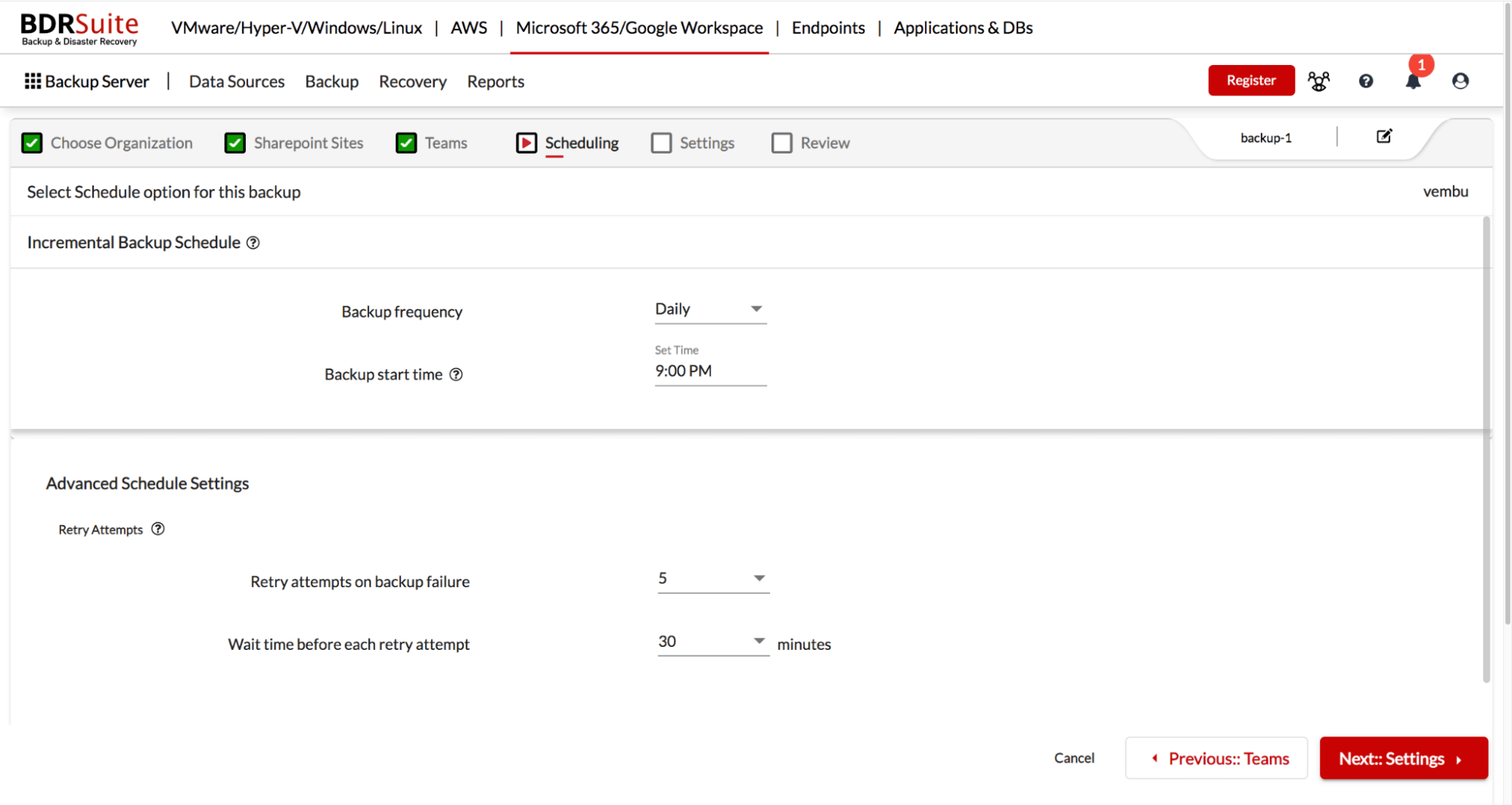
6. Settings:
On this page, you will be able to configure Compression and Retention settings for this backup.
- By default, all the backup data is compressed while stored in the backup repository. If disabled the original size of the backup data will be stored
- BRetention allows you to retain only a specified number of versions of your backup data (Teams). You can customize the retention settings based on your requirements.
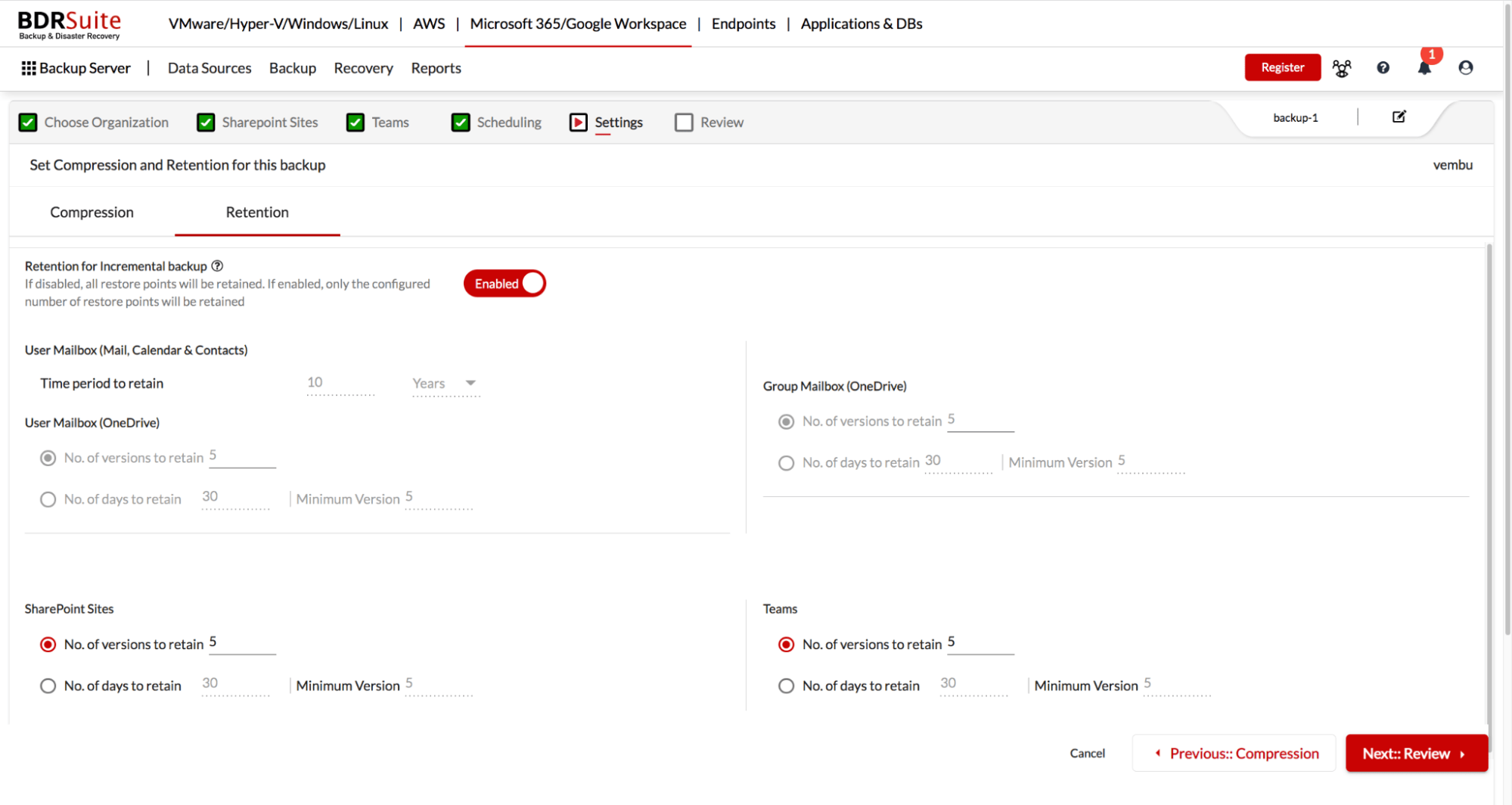
Review:
Lastly, review the backup configuration and save the backup job. The backup will start to run based on the configured scheduling policy (or) you can immediately schedule the job by enabling the checkbox “ Run this backup job after saving”.
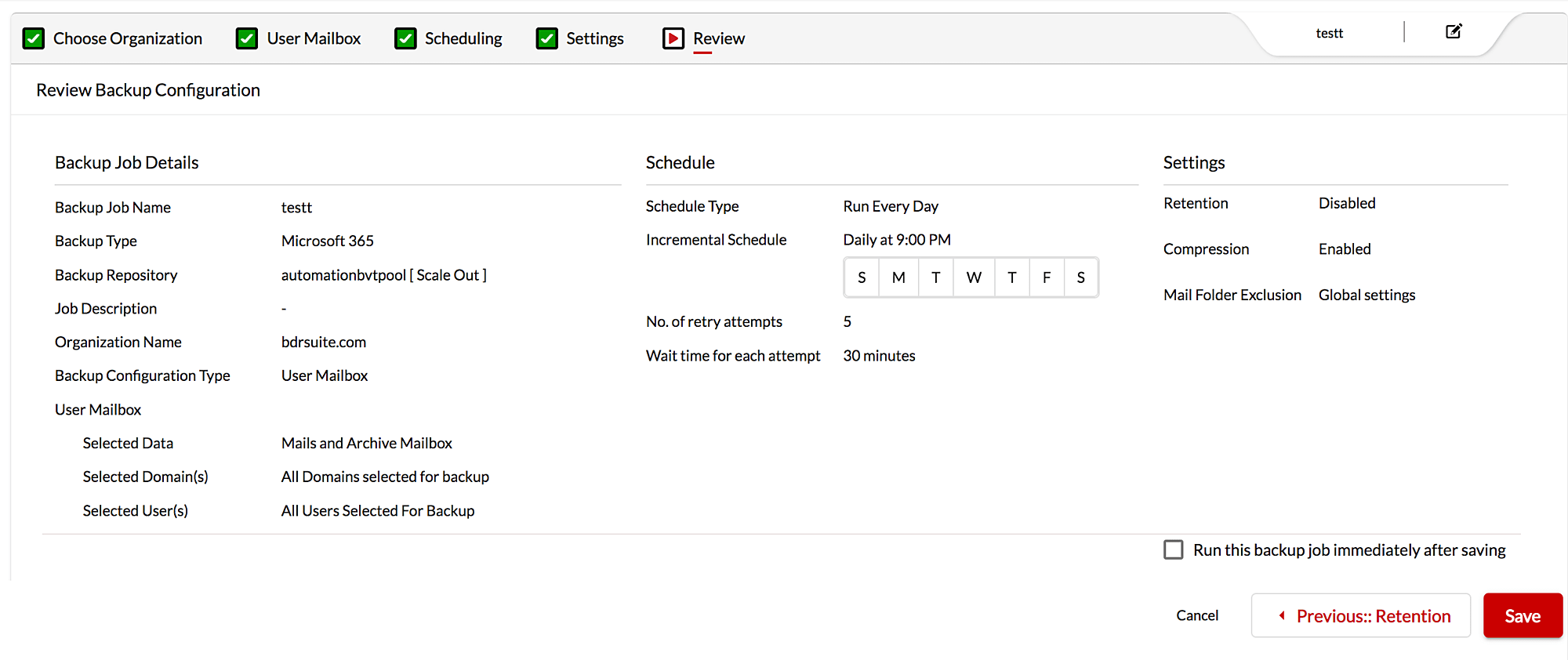
How to Restore User Mails/Archive Mails to Different Organization
1. Navigate to the Recovery page. All the backup jobs will be listed here. Click on the ‘Restore’ button alongside the job you want to restore.
2. Choose Restore Type: On this page, select the ‘Restore User Mailbox’ Option.

3. Choose the domain in which the user you want to restore is available.

4. Then, select the restore version (from which backup you want to restore) and click next.
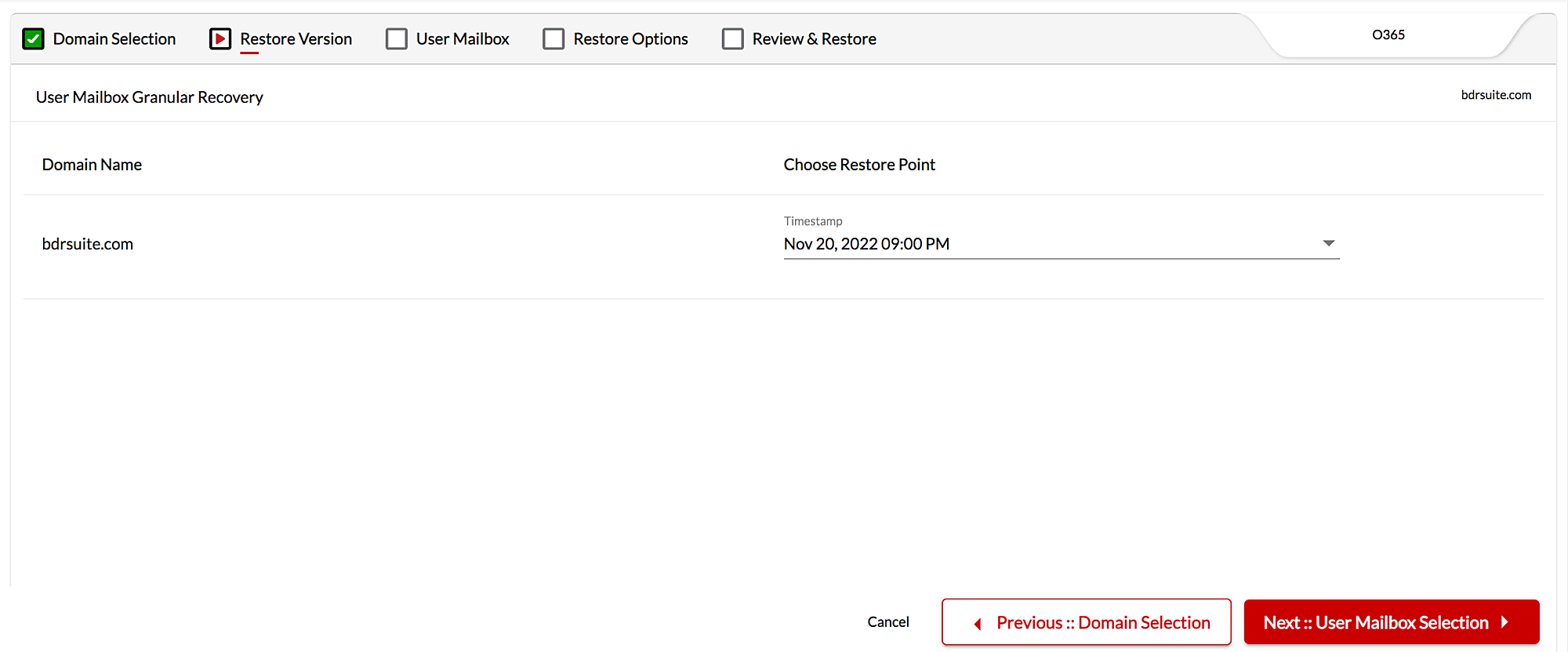
5. User Mailbox Selection: Choose the mailbox and then select the data either ‘Mails’ or ‘Archive Mailbox’. Here I’m choosing Mails. Then you can select all the mail folders or specific mail items and proceed to the next step.
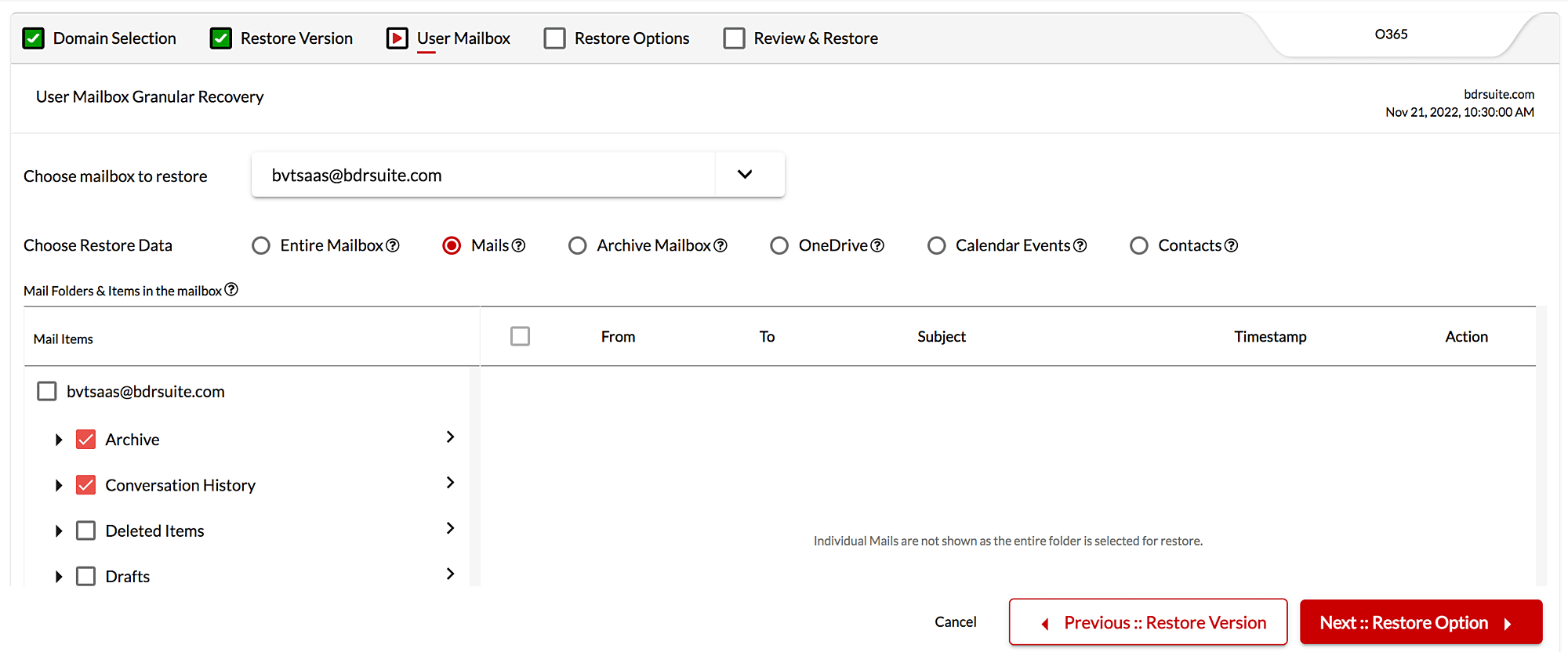
6. Restore Option: Choose the restore option as “Restore to Different Organization”. Make sure you have already added the organization under the Data Sources menu
- Select the target organization and a user mailbox in it to restore the selected mail folders/items
- You can also choose to restore all mails or mails within a specific date range
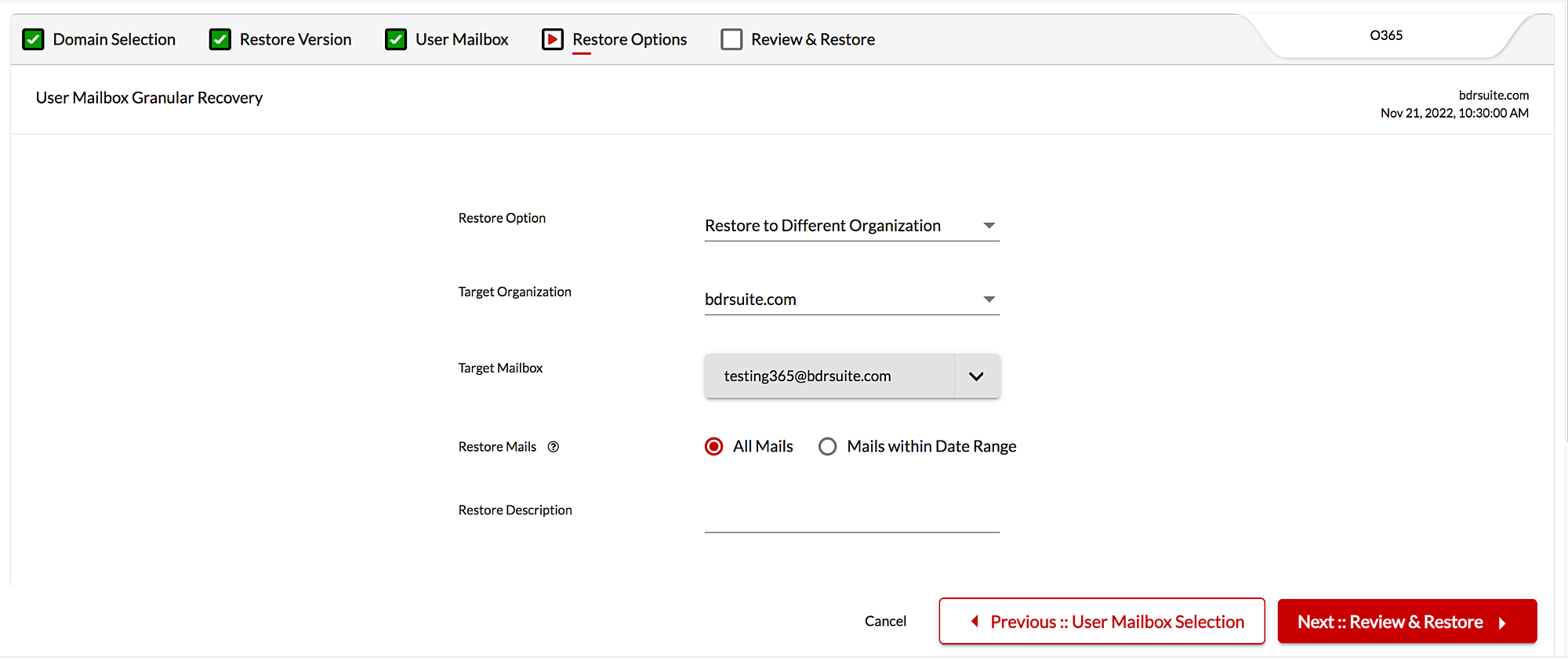
7. Review & Restore: Review the restore configuration and click the ‘Restore’ button to initiate the recovery. You can check the restore progress from the recovery page. The mail folders/items you chose to restore will be successfully restored to the selected mailbox in a different organization.
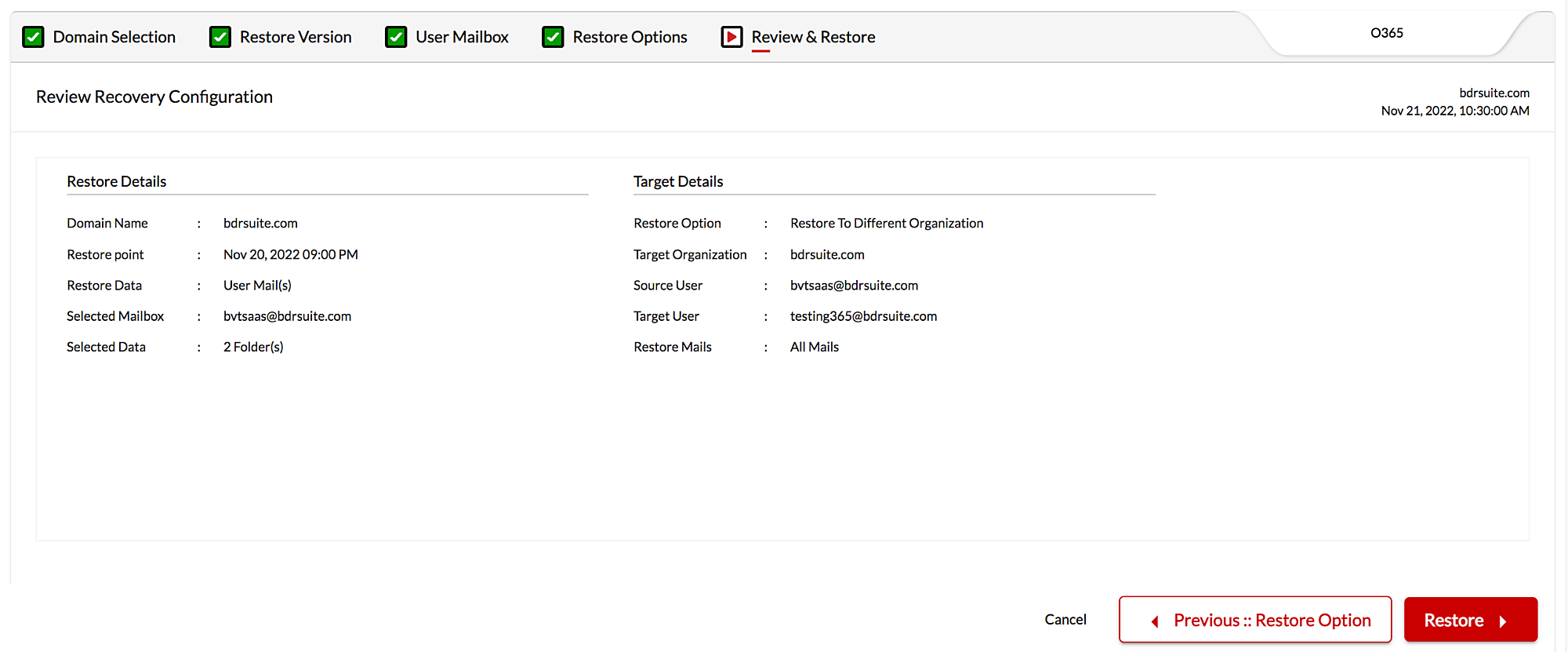
Be sure to download and explore BDRSuite in your environment with our fully-functional 30-day free trial version
Follow our Twitter and Facebook feeds for new releases, updates, insightful posts and more.


Leave A Comment